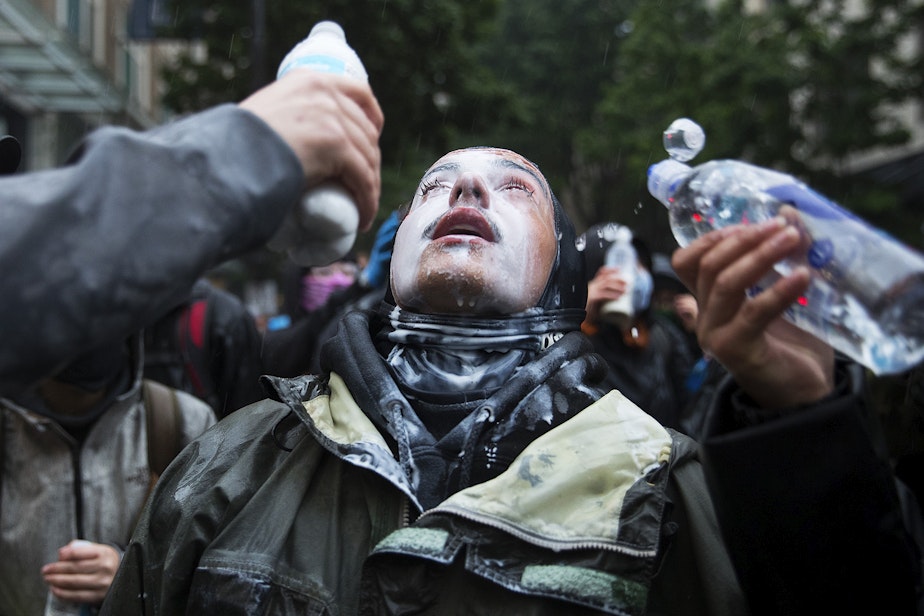Seattle Police will stop using tear gas on protesters, chief says

Carmen Best, chief of the Seattle Police Department, announced on Friday that her officers would stop using tear gas on protesters.
Seattle had not used tear gas since the World Trade Organization protests of 1999, she said, and during the protest on Saturday night, the department turned to tear gas because it had nearly depleted its supply of pepper spray and blast balls.
“Because of the magnitude of the event, we experienced a near-depletion of the supply of those tools,” Best said.
Protesters have gathered every day in Seattle since Friday, a week ago, to protest police use of force, and specifically the killing of George Floyd by Minneapolis police. Floyd became unresponsive as an officer kneeled on his neck.
The protests have evolved to focus on police accountability in Seattle.
On Saturday, the protest, which began peacefully, became aggressive. More demonstrators joined in the afternoon and evening, and clashed with police. A cloud rose above downtown as flash bangs were thrown and gas sprayed to disperse the crowd.
Sponsored
Advocates started demanding that tear gas stop being used after Saturday. The gas, known as CS gas, essentially paralyzes people for a little while as their eyes, mouth, and lungs burn from the irritation.
Doctors also weighed in, saying that using tear gas in a pandemic could exacerbate spread of the coronavirus.
The suspension will last 30 days, and does not apply to SWAT officers in a standoff situation.
Best said she met with her command team to discuss the use of tear gas, and that they will ask Seattle's police oversight agencies as well as outside police reviewers to examine their crowd control policy.
Tear gas is controversial, and deemed a “method of war” by the Geneva Protocol. But it has been allowed for riot control.
The Seattle Police manual allows the use of blast balls and pepper spray (or “OC spray”) to disperse a crowd – but only “if an immediate life safety emergency exists.” A lieutenant must order it.
Sponsored
The Seattle Community Police Commission has been asking Seattle Police to limit its use of blast balls for years.
Now Best and Mayor Jenny Durkan say the commission and other oversight agencies will take the lead on reviewing the department’s crowd management policies.
Lisa Herbold, a city council member, said Wednesday during a meeting that the use of these chemical agents shocked her.
"I've never in 25 years of participating in protests in the City of Seattle experienced such an indiscriminate use of tear gas, pepper spray and flash bombs against people,” she said, “with so little effort to de-escalate, to negotiate with protesters, to utilize peacekeepers who are willing to help you.”
In the last week, Chief Best and Mayor Jenny Durkan have eased up on some of their more draconian measures. They have removed the curfew, which started as early as 5 p.m. on Saturday and Sunday, and Best ordered her officers to stop obscuring their badge numbers.
Sponsored
Police body cameras, currently turned off for peaceful protests, could be turned back on. Durkan said she is open to revising the policy.
“The body-worn video policy was put in place by the previous mayor and council after consultation with civil liberty groups that did not want peaceful protests being video recorded by the police,” Durkan said Friday. “I think those civil liberty concerns are still valid, but I think that we’ve changed as a city and people's expectations have changed. SPD is ready to turn those cameras on but I’m going to be asking the City Council, working together with the CPC, our civil liberties groups and other stakeholders, to take a look at that policy and determine whether it needs to be updated.”
Seattle's Office of Police Accountability is investigating complaints that officers failed to record “law enforcement activity” on body-worn cameras during the recent demonstrations. But officers did record some interactions; the OPA says there is relevant body-worn video related to many of the complaints that is being reviewed.



